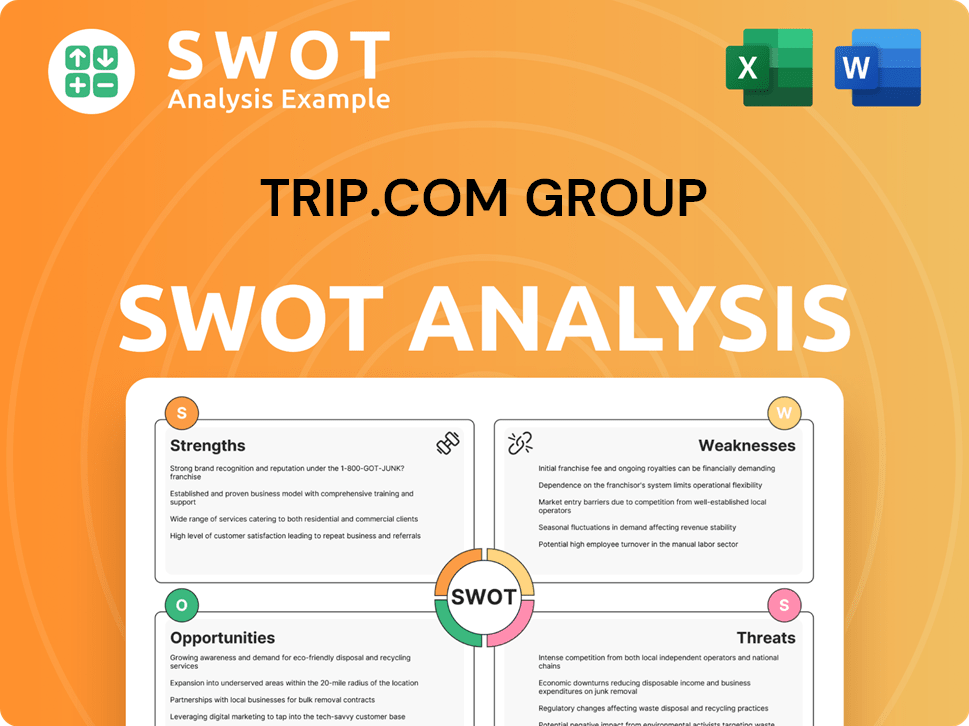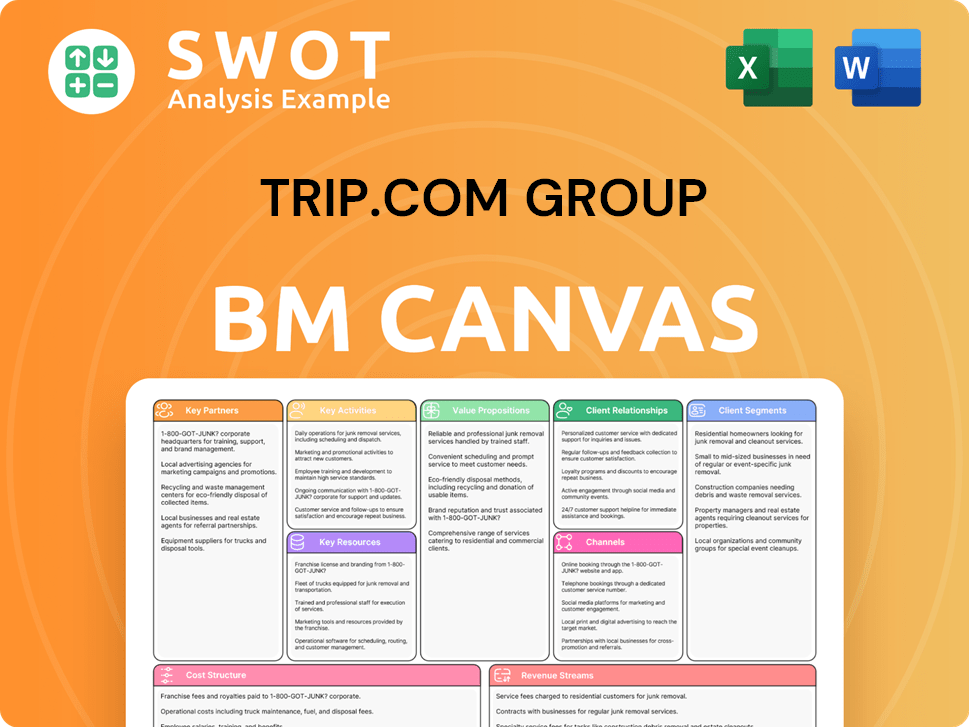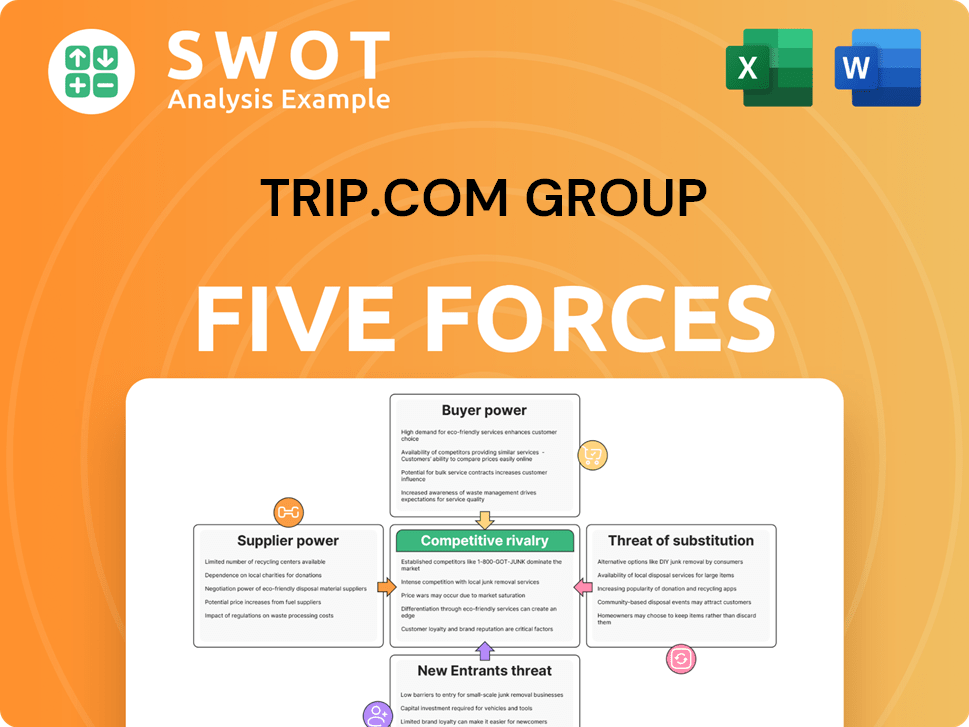Trip.com Group Bundle
How has Trip.com Group conquered the global travel market?
Witness the remarkable transformation of Trip.com Group, a company that has redefined the travel landscape through strategic innovation. From its humble beginnings in China to its current status as a global powerhouse, Trip.com Group's journey is a masterclass in adaptability and technological prowess. Discover how they leverage cutting-edge AI, like TripGenie, to personalize travel experiences and stay ahead of the curve.

This deep dive explores the core of Trip.com's success, examining its Trip.com Group SWOT Analysis, sales and marketing strategies, and the evolution of its business model. We'll dissect their approach to online travel agency marketing, including their digital marketing strategy and how they acquire customers globally. Understanding Trip.com's sales strategy, marketing campaign examples, and market analysis provides invaluable insights for anyone interested in the travel industry's future.
How Does Trip.com Group Reach Its Customers?
The success of the Target Market of Trip.com Group hinges on its diversified sales channels, which enable it to reach a global audience effectively. This strategy combines robust online platforms with a physical presence, particularly in key markets. The company's approach to sales is a dynamic mix of digital innovation and strategic partnerships, driving its market share and customer engagement.
Trip.com Group's sales strategy is heavily reliant on its digital presence. The company has invested significantly in its mobile applications and localized websites. These channels are designed to provide users with a seamless experience for exploring, reserving, and purchasing travel products and services.
In 2024, mobile channels accounted for over 90% of the total transaction orders. This highlights the importance of mobile platforms in the company's sales strategy. The Trip.com app has become a leading online travel agency (OTA) app in several markets, including South Korea, Singapore, Thailand, and Hong Kong.
Trip.com Group primarily utilizes its mobile applications and localized websites as its main online sales channels. These platforms allow customers to search, reserve, and purchase various travel products. The company focuses on enhancing user experience and expanding its digital reach.
While the company's focus is digital, Trip.com Group maintains a significant offline presence with approximately 6,000 offline stores across around 300 cities in China as of December 31, 2024. These physical stores support the online strategy.
Trip.com Group actively forms partnerships with airlines, hotels, and other travel companies to offer exclusive deals. Recent collaborations include partnerships with Saudia, Flynas, and Emirates, expanding its global reach. These partnerships are key to its marketing strategy.
The company is strategically integrating its online and offline channels to provide a seamless customer experience. This omnichannel approach is driven by the shift from offline to online and mobile services, particularly in the Asia-Pacific region. This is a core element of its Trip.com sales strategy.
Trip.com Group's sales strategy focuses on digital dominance, strategic partnerships, and omnichannel integration. The company aims to enhance its market share and customer engagement through these initiatives.
- Mobile-First Approach: Prioritizing mobile applications for transactions.
- Exclusive Deals: Collaborating with partners to offer unique travel packages.
- Global Expansion: Leveraging partnerships to extend its reach in key markets.
- Customer Experience: Enhancing the user experience across all channels.
Trip.com Group SWOT Analysis
- Complete SWOT Breakdown
- Fully Customizable
- Editable in Excel & Word
- Professional Formatting
- Investor-Ready Format

What Marketing Tactics Does Trip.com Group Use?
The marketing tactics of Trip.com Group are multifaceted, designed to build brand awareness, generate leads, and boost sales. They heavily rely on digital strategies, utilizing various online channels to reach a broad audience. This approach is central to their Trip.com marketing strategy, ensuring a strong presence in the competitive travel industry.
Data-driven marketing and personalization are key components of Trip.com Group's strategy. They leverage big data and AI to analyze customer behavior and tailor marketing efforts. This allows for personalized recommendations and an enhanced booking experience, improving customer engagement and satisfaction. The company's investment in marketing, with approximately $1.6 billion spent in 2024, reflects its commitment to these strategies.
Beyond digital channels, Trip.com Group incorporates traditional media and strategic partnerships. These tactics enhance brand visibility and reach specific target markets. Their ability to innovate and adapt, such as incorporating live streaming, has significantly impacted their sales performance. For a deeper understanding of the company's financial structure and revenue streams, consider exploring the Revenue Streams & Business Model of Trip.com Group.
Trip.com Group's digital marketing strategy includes content marketing, SEO, paid advertising, email marketing, influencer partnerships, and social media. These channels are essential for customer acquisition. The company's focus on digital platforms is a core aspect of its Trip.com sales strategy.
AI-powered tools like 'Trip.Best,' 'Trip.Deals,' and 'Trip.Trends' provide personalized recommendations. TripGenie, the AI travel assistant, saw a 200% increase in traffic and nearly a 100% increase in browsing time in 2024. This highlights the effectiveness of AI in enhancing customer engagement.
Trip.com Group uses TV advertising and airport activations to increase brand visibility. Strategic partnerships with lifestyle TV shows, such as the Korean reality program 'Unexpected Business' and the Thai reality competition 'Chuang Asia: Thailand,' amplify reach in key markets. This approach ensures a broader market penetration.
The social platform Trip Moments was central to the '100 Ways of Travel' global campaign in 2024, encouraging user-generated content and engagement. This campaign increased brand awareness. This social media focus is a key component of their Trip.com business model.
Live streaming on the Trip.com platform generated US$1.4 billion in gross merchandise value (GMV) on its Ctrip platform since its launch in 2020. This innovative approach has significantly contributed to sales. The company continues to adapt its marketing strategies to stay ahead of the competition.
Trip.com Group invested approximately $1.6 billion in marketing across 2024, a 29% increase year-over-year. This substantial investment underscores the company's commitment to growth and market expansion. This investment is a strategic move to enhance its competitive advantage.
Trip.com Group's marketing tactics are designed to reach a wide audience and drive sales. They focus on digital channels, personalization, and strategic partnerships. These approaches are critical for success in the travel industry, ensuring effective customer acquisition and retention.
- Digital Marketing: Content marketing, SEO, paid advertising, email marketing, influencer partnerships, and social media.
- Data-Driven Marketing: Leveraging big data and AI for customer segmentation and personalized recommendations.
- Traditional Media: TV advertising and airport activations to enhance brand visibility.
- Strategic Partnerships: Collaborations with lifestyle TV shows to amplify reach in key markets.
- Innovation: Incorporating features like live streaming to drive sales and engagement.
Trip.com Group PESTLE Analysis
- Covers All 6 PESTLE Categories
- No Research Needed – Save Hours of Work
- Built by Experts, Trusted by Consultants
- Instant Download, Ready to Use
- 100% Editable, Fully Customizable

How Is Trip.com Group Positioned in the Market?
The brand positioning of Trip.com Group is centered on being a leading global one-stop travel platform. This is achieved through a comprehensive suite of travel products and services, differentiated travel content, and a user-centric approach. The core message revolves around 'pursuing the perfect trip for a better world,' highlighting convenience, affordability, and reliability, making it a go-to destination for travelers.
The company targets a diverse audience, including leisure and business travelers, families, and solo travelers, catering to various age groups and income levels. In 2024, the company received recognition in Fortune Asia Future 30 and the Forbes China Best Employer Award, reflecting its strong brand image and appeal. The focus is on providing tools for exploration, inspiration, informed and cost-effective bookings, on-the-go support, and travel experience sharing.
A key element of Trip.com Group's brand strategy is its growing emphasis on sustainability. This focus resonates with a growing consumer preference, as 72.4% of travelers are attracted to OTAs that highlight sustainable travel offerings. The company aims to achieve carbon neutrality by 2050 and is actively introducing lower-carbon travel products, aiming to offer over 10,000 such products and enable 100 million travelers to consider adopting lower-carbon practices.
Trip.com Group prioritizes a seamless and enjoyable travel experience, reflected in its visual identity and tone of voice. This approach ensures that the platform remains user-friendly and appealing to a broad audience. The platform focuses on providing tools for exploration and inspiration, making travel planning easier.
The platform offers a wide array of travel products and services, including flights, hotels, and activities. This comprehensive approach allows travelers to find everything they need in one place. This strategy supports its position as a one-stop travel platform, enhancing convenience for users.
The company is committed to sustainability, aiming for carbon neutrality by 2050. They are introducing lower-carbon travel products. This focus on sustainability appeals to environmentally conscious travelers and enhances the brand's image.
Trip.com Group aims to be the go-to destination for travelers worldwide, with a strong presence in Asia and growing global efforts. This expansion strategy is supported by its digital marketing strategy and partnerships. This global approach is a key element of its business model.
The brand positioning of Trip.com Group is built on several key pillars, including a user-centric approach, a wide range of travel services, and a commitment to sustainability. These elements work together to create a strong and appealing brand identity.
- Convenience: Providing a one-stop platform for all travel needs.
- Affordability: Offering cost-effective booking options.
- Reliability: Ensuring a trustworthy and dependable service.
- Sustainability: Focusing on eco-friendly travel options.
- Global Presence: Expanding its reach to serve travelers worldwide.
Trip.com Group Business Model Canvas
- Complete 9-Block Business Model Canvas
- Effortlessly Communicate Your Business Strategy
- Investor-Ready BMC Format
- 100% Editable and Customizable
- Clear and Structured Layout

What Are Trip.com Group’s Most Notable Campaigns?
The sales and marketing strategies of Trip.com Group are characterized by impactful campaigns designed to boost brand visibility and drive user engagement. These initiatives leverage a mix of digital platforms, strategic partnerships, and product-specific promotions to reach a global audience. The company's approach focuses on both acquiring new customers and retaining existing ones through compelling content and targeted offers. This strategy is crucial for maintaining its competitive edge in the online travel agency (OTA) market.
A key element of Trip.com's Brief History of Trip.com Group sales and marketing strategy involves a focus on user-generated content and social media engagement. By encouraging travelers to share their experiences, the company not only generates organic content but also fosters a sense of community. This approach is complemented by strategic partnerships and product-specific promotions that cater to evolving consumer preferences, particularly in areas like sustainable travel. Through these multifaceted campaigns, Trip.com aims to solidify its position as a leading OTA.
Trip.com Group's campaigns are designed to resonate with a global audience, incorporating diverse marketing channels and innovative strategies. These efforts are crucial for sustaining growth and adapting to the dynamic nature of the travel industry. By continuously refining its approach and responding to market trends, Trip.com aims to enhance its market share and strengthen its brand presence.
Launched from August 8 to November 16, 2024, on Trip Moments, this global campaign encouraged users to share travel moments. Participants could win up to USD$5,000 in Trip Coins and opportunities for long-term collaboration. The campaign utilized user-generated content and social engagement to drive participation.
In 2024, Trip.com partnered with Tourism Malaysia to expand its reach in the Asia Pacific region. They also collaborated with VGI Airports for a brand campaign at Kuala Lumpur International Airport (KLIA) in November 2024. These partnerships boost brand visibility and market penetration.
The 'Low-Carbon Hotel Initiative' and promotion of lower-emission flights cater to eco-conscious travelers. These efforts are part of a broader strategy to align with the increasing demand for sustainable travel options. This approach is supported by the 2024 Sustainable Travel Consumer Report.
Sponsorship of TV shows like 'Unexpected Business' and 'Chuang Asia: Thailand' helps engage younger audiences. Themed rooms and giveaways are designed to amplify reach in key Asian markets. This strategy combines entertainment with promotional activities.
Trip.com's marketing campaigns utilize a variety of strategies to engage customers and drive sales. These include user-generated content, strategic partnerships, and product-specific promotions. The focus is on creating a comprehensive approach that resonates with a global audience.
- User-Generated Content: Encouraging travelers to share experiences through platforms like Trip Moments.
- Strategic Partnerships: Collaborating with tourism boards and other entities to expand market reach.
- Product-Specific Promotions: Highlighting sustainable travel options and themed campaigns.
- Social Media Engagement: Utilizing social media to build brand awareness and interact with customers.
Trip.com Group Porter's Five Forces Analysis
- Covers All 5 Competitive Forces in Detail
- Structured for Consultants, Students, and Founders
- 100% Editable in Microsoft Word & Excel
- Instant Digital Download – Use Immediately
- Compatible with Mac & PC – Fully Unlocked

Related Blogs
- What are Mission Vision & Core Values of Trip.com Group Company?
- What is Competitive Landscape of Trip.com Group Company?
- What is Growth Strategy and Future Prospects of Trip.com Group Company?
- How Does Trip.com Group Company Work?
- What is Brief History of Trip.com Group Company?
- Who Owns Trip.com Group Company?
- What is Customer Demographics and Target Market of Trip.com Group Company?
Disclaimer
All information, articles, and product details provided on this website are for general informational and educational purposes only. We do not claim any ownership over, nor do we intend to infringe upon, any trademarks, copyrights, logos, brand names, or other intellectual property mentioned or depicted on this site. Such intellectual property remains the property of its respective owners, and any references here are made solely for identification or informational purposes, without implying any affiliation, endorsement, or partnership.
We make no representations or warranties, express or implied, regarding the accuracy, completeness, or suitability of any content or products presented. Nothing on this website should be construed as legal, tax, investment, financial, medical, or other professional advice. In addition, no part of this site—including articles or product references—constitutes a solicitation, recommendation, endorsement, advertisement, or offer to buy or sell any securities, franchises, or other financial instruments, particularly in jurisdictions where such activity would be unlawful.
All content is of a general nature and may not address the specific circumstances of any individual or entity. It is not a substitute for professional advice or services. Any actions you take based on the information provided here are strictly at your own risk. You accept full responsibility for any decisions or outcomes arising from your use of this website and agree to release us from any liability in connection with your use of, or reliance upon, the content or products found herein.